
提及“写意”一词,在以普遍惯性思维为主导的艺术概念认知范畴内,其含义并不难理解,往往更多的使人联想到中国传统绘画中的一种绘画风格样式,也就是常说的“写意绘画”。关于写意的概念是什么,不能以与写实相对应的简单逻辑思维来诠释,写意应该有更深邃的内涵。然而即便在《辞海》《辞源》中,也将写意一词在诠释的条目中理解为中国绘画的一种表现方法,或以中国绘画中与工笔相对应的粗笔一路加以理解。这种理解有一定的普遍性,但就“写意”这一称谓,抑或叫作绘画名词,从其内涵指向而言,更契合一种源于文明演进的文化自觉和审美崇尚,并通过各种写意的展现形式反映在社会生活的方方面面,这在中国绘画艺术中尤为凸显,需要进一步深入思考和探讨。当然,关于写意的感性和理性反思,并不会直接影响到具体的绘画实践,只是换个角度和维度,去再认识中国写意绘画的人文内涵、审美诉求和精神实质。
When it comes to the term“Xie Yi”[1], it is not difficult to understand in the context of the commonly tradition-driven conception of Chinese art, and is often more associated with a traditional Chinese painting style, which is often referred to as “Xie Yi painting”.The concept of Xie Yi cannot be.The literal translation of the term is to write down the meaning. As Chinese painting uses the same brush and techniques for writing, painting is often referred as writing. In the context of Chinese painting, it refers to the freehand and impressionistic painting style.interpreted in the simple logical way that corresponds to realistic; it should have a deeper connotation.Yet even in the Dictionaries, the term is still interpreted as a method of expression in Chinese painting, with rough brushstrokes that are the counterpart of Fine-line paintings.There is a certain logic in this understanding, but in terms of Xie Yi as painting genre, its connotation is more in line with a cultural consciousness and aesthetic reverence that originates from the evolution and is reflected in all aspects of social life through various forms of expression. It is particularly prominent in Chinese painting and requires further reflection and exploration.Of course, the perceptual and rational reflections on Xie Yi do not directly affect any specific painting practice, but only on how to re-understand the humanistic connotation from different perspectives of aesthetic and spiritual essence of Chinese painting.
在当代中国绘画中,往往将“写意”与“工笔”相对应,这种理解,基本已经成为一种约定俗成的固化概念,甚至有些深谙中国绘画的专业人士也直接就将写意或工笔作为自身从业的技艺代名词,由此还出现了对应的画家及展览。当然,基于当代中国的大众文化认知和艺术人文背景状况,这也是无可厚非的,毕竟如果从发展的眼光来看待一切事物,为某一名词注入和扩容新的时代内涵,也不失为一种合理的解释。但问题出来了,写意是不是真的就可以用如此显而易见的概念轻而易举地从我们的认知中一笔带过,不需要再去深层次的反思了?依我看,当然不是,关于写意大有文章可做。甚至可以说,在一定程度上,我们都或多或少基于某种绘画语言的审美直觉和主观经验,被集体引入了一个臆断的概念误区,以致越来越偏离写意的本质内涵,从而导致对一些基本的绘画问题,出现了理解上的偏颇与误解,其结果就是出现针对中国绘画发展问题上的取向迷茫和硬性嫁接。就写意问题所连带出来的学术问题,也是当今学术界争论和探讨的主要问题。这里借此机会,也谈谈自己关于写意的一些想法和认识,语出卮言,信笔随思,绝无所指。
In contemporary Chinese painting, the terms Xie Yi and Fine-line are often used in opposition to each other. This proposition has basically become an established concept, with some professionals who are well versed in Chinese painting even directly using Xie Yi or Fine-line as a synonym for their own practices, and further led to the emergence of corresponding names of the painters and exhibitions.Of course, given the state of popular awareness and background in contemporary China, this is no problem. But, if one looks with the lens of the times, it is only reasonable to inject and expand a term with new connotations for its development. But the question arises, is it really possible to use such a concept to pass down the perception without further reflection? In my opinion, of course not. There is much to be said about Xie Yi.It can even be said that, to a certain extent, we have all been led collectively into a conceptual misunderstanding based more or less on our aesthetic intuition and subjective experience of a certain painting language. It has led to an increasing deviation from the essential connotation of Xie Yi, resulting in a biased and misunderstanding of some basic painting issues such as the confused or rigid grafting of ideas in the development of Chinese painting.The problems associated with Xie Yi are also major issues of debate and discussion in academic circles today. I would like to take this opportunity to share with you some of my thoughts and understandings on the subject of painting.The words come out of the goblet and are written as they come to mind. There is no intention to criticize on any specific person.
作为一名从事中国绘画的教育工作者和实践者,曾在很长一段时间里,都在思考写意和工笔作为对应风格称谓的合理性问题。写意和工笔这种称谓在人物画和花鸟画中最为普遍,在山水画中几乎没有这样的称谓或叫法,当然可能也有人喜欢和愿意这样称呼,但皆为个例,不具有普遍性。写意和工笔,这种称谓如果是从表现方法和技艺风格上来区分,本人觉得用粗犷法和精细法来区别或许更为贴切。写与工不是对应的关系,而是互补的关系。这种互补关系用书法中的“行草如楷,行楷如草”来形容或许比较便于理解。如果用图像来阐释,也可从北宋崔白《双喜图》(图1)中草木的勾勒方法上获得些启迪。大凡从事绘画的人都有这样的体会,行笔运墨,既要奔放还要收得住,勾勒设色既要平稳还要甩得开,点厾挥写,既不肆意妄为,也不谨小慎微,而是要张弛有度,这个张弛有度,就是“写”。中国绘画追求以写为上,并且是在“写”的基础上进行精度制作,这个制作也是一种写的过程,是基于画面虚实和主次的深入点染刻画,而不是思维停滞的勾描和涂抹,更不是磨洋工。因此,对勾皴点染而言,都应是写的过程,虽不必笔笔有出处,但要处处见法度。再说一下“意”,意是个大问题,可以做大文章,但这就先不展开了。仅对中国绘画而言,意可以暂且通过字面的意思来加以判断,从意的词组中,可以先梳理出几个关键词,譬如意趣、意境、意念、意图等,或者再简单直接说,意即内心的想法、情感、思绪、感受等。那么写意的意,和工笔要传达的意本身是不是一样的?我的回答是肯定的,工笔也是一种意的表达方式。由此可见,粗犷的“写意”和精细的“工笔”只是绘画表现方法上和所呈现出来的视觉感受上有所不同,但就绘画过程的“写”和最终要获得的“意”其实是一样的。从法度上讲,没有谁高谁低。那么既然是一样的,用写意的称呼和工笔来对应,显然是不贴切的。我们甚至可以说,工笔画本身也是写意画,仅仅是表现技法上有所不同而已。如果用粗笔与细笔来区分,字面上似乎对仗了,但似乎又不是这个笔粗和笔细的意思,更不是线条粗细的概念。如果用抽象和具象来表述,也是不合理的,因为在形的问题上,粗犷和精细两种表现手法最终的绘画目的也是一样的,即“传神阿睹”。写意不是放任随意,工笔不是结板刻意,而同是抒发情感的不同绘画方式。这个的确有点纠结,那到底怎样的称谓才算合理,或许暂且将粗犷法称为意笔,将精细法称为工笔,可能比较合适,在当下也比较容易被接受。但意笔也好,工笔也好,都应该统称为中国写意画,只是描写画面意象的方法有所不同罢了。这一观点似乎有点逆天,那我们再来继续分析一下中国写意绘画的内涵,或许会有新的意味浮现出来。
As an educator and practitioner of Chinese painting, I have for a long time pondered the question of the rationality of the terms Xie Yi and Fine-line as corresponding styles. The term, Xie Yi or Fine-line, is most commonly used in figure painting as well as bird-and-flower painting, but hardly ever in landscape painting. Although there may be people who prefer and are willing to call them that, they are eceptional cases and not common.I think it would be more appropriate to distinguish between the rough and fine methods of expressions in painting techniques. Xie Yi and Fine-line are not exclusive to, but in complementary with each other. This complementary relationship is perhaps better described by the saying in calligraphy “Running cursive script is as regular, running regular script is as cursive)”.Interpreted in pictorial terms, some inspiration can be drawn from the way the grass and trees are outlined in Cui Bai's Magpies and Hare(Illustration 1) from Northern Song Dynasty.Anyone who has ever been involved in painting has the experience that the brushwork must be unrestrained, the outline and colouring must be smooth and open. Painting must not be reckless or cautious, but rather relaxed. Chinese painting pursues expressiveness as its top priority, and is done with precision on the basis of “Xie”, which is also a process of writing, based on the depth of dabbing and colouring of the picture, rather than stagnant sketching and coloring, let alone repetition. Therefore, the process of painting should be a process of writing. Although it is not necessary to have a referential for each brushstroke, the intention should be seen clearly. The Yi (意meaning, intention) is a big issue and can be the subject of a great deal of discussion, but I will not expand on this. In the case of Chinese painting alone, Yi can be interpreted by its meaning in the phrases: several key words can be sorted out, such as interest, mood, idea and intention . Yi is the inner thoughts, emotions, thoughts and feelings. So is it the same as the Yi imbedded in Fine-line paintings? My answer is yes, Fine-line is also a form of expression. It can be seen that the difference between rough Xie Yi and delicate Fine-line is only in the method of expression and the presented visual experience. The painting process of Xie and the Yi of the painting are in fact the same. In terms of technique, there is no superiority or inferiority.Since they are the same, then, it is clearly inappropriate to use the terms to differentiate the two. We might even say that Fine-line painting itself is also in essentially Xie Yi , merely differing in the expression techniques. If we only use the distinction between thick and thin strokes, it may seem to be literally correct. But it actually does not seem to be of the idea about the lines. It would be unreasonable to use abstract and figurative expressions, because in terms of form, the ultimate aim of painting is the same for both, i.e. to “convey the spirit”. Xie Yi is not arbitrary, while Fine-line is not overly deliberate, they are but different ways of expressing emotion. This indeed is a tricky problem. Perhaps it would be more appropriate to refer to the rougher method as Xie Yi and the finer method as Fine-line. It would be more acceptable for now. No matter Xie Yi or Fine-line, they should be collectively referred as Chinese painting, with only the method of depicting being different. This view seems a little counterintuitive, so let us continue to analyse the connotations of Chinese painting in the sense that new meanings may emerge.
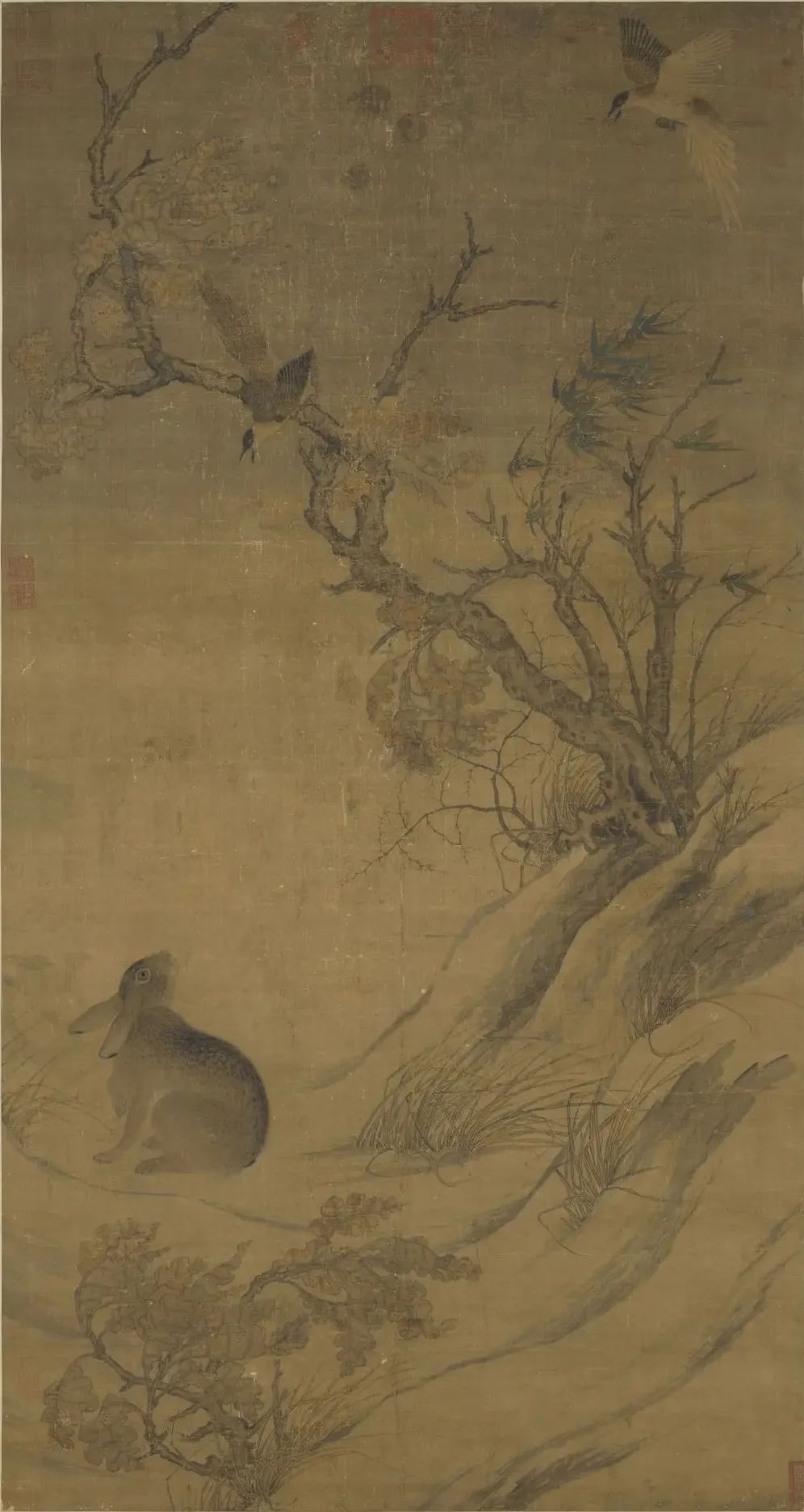
Cui Bai, Magpies and Hare, 193.7×103.4cm, Northern Song Dynasty,Taipei Palace Museum中国绘画当代被称为中国画,就中国画这个称谓而言,也有些牵强,具体就不多言了,因为不是这里要探讨的问题,就暂且用“中国画”这一词来特指中国绘画。首先划定一个地域空间,就是以当代的中国疆域包括特别区域为基准,凡现存的一切平面绘画样式,无论古今或是否延续和消亡的人工绘画艺术样式,都可称为中国绘画。那么这样就不难理解了,中国绘画的范围非常大,有些以题材样式划分,有些以地域民族划分,有些以材料质地划分,有些以功能目的划分,等等,可谓包罗万象,但这些绘画都具有一个比较明显的共性特征,就是写意性。这个论断是不是合理,接下来可以尝试深入探讨。
As far as the term Chinese painting is concerned, it is somewhat compromised.I will not say too much about it, as it is not the issue to be discussed here. I will use the term “Chinese painting” to refer specifically to the more general painting in Chinese for the time being.First of all, a geographical space is defined, that is, the contemporary territory of China including some special regions. All existing graphic painting styles in this region, whether ancient or modern, whether still in continuation or extinct, can be called Chinese painting.It is easy to understand, then, that the range of Chinese painting is very large, in its subject matters and styles. The categorization could be done based on their regions and ethnicity, or by the materials and textures used, or by the functional purposes. One of the more obvious common characteristics of all these paintings is Xie Yi. Whether or not this assertion is justified? I’ll try to explore in depth.
这里要说明一点,由于中国所处的特殊地理位置和所具有的世界文化身份,中国绘画自然也就有了绝对的东方绘画代表性地位。这种代表东方的写意性绘画与西方以写实性为发展基础的绘画样式形成颉颃并峙的关系,逐渐成为一道东方视觉文化的风景线,散布在东方大地,也影响着东方各个区域的绘画艺术发展,并扮演重要角色。
It is important to note here that because of China's special geographical location and its global cultural identity, Chinese painting naturally has an absolute representative status in Oriental paintings.This representational style of painting has formed a parallel relationship with the Western style of painting based on realism, and has gradually forged an oriental visual cultural that is influencing and playing important roles in the development of painting throughout the East.
这种与西方写实性绘画相对应的写意性绘画,伴随中国文化的不间断性被延续至今。从时间上看,中国的这种写意性绘画远远要早于西方写实性绘画。众所周知,西方写实性绘画的发轫和成熟期是在文艺复兴时期,而中国绘画的成熟期是在唐宋,如果从发端,可上溯到两汉时期,可参见马王堆帛画,从帛画的表现技艺和形式内容上看,都呈现了明显的意象特征。而且在两晋时期,绘画理论已经达到相当的高度,如顾恺之的著作《魏晋胜流画赞》《论画》,南朝宋宗炳的《画山水序》,南齐谢赫的《古画品录》,南北朝时期姚最的《续画品》,若按照有些文献著述中的人物记述品评,时间还要更早。从这些重要的绘画文献中,我们不难感受到一点,就是先贤对于绘画的理论已经有了极高的造诣,且见解独到,论述精辟,耐人寻味。在文献表述中,也可以体味到先贤对绘画意象问题的真知灼见,以及对绘画“形神”问题的阐幽抉微。由此我们可以得出这样一个结论,中国绘画就是基于中国传统文化思想发展脉络上的,针对写形和造境问题的写意性绘画,这与我们现如今理解的写意指向性概念有些大相径庭,写意的内涵远比我们的理解要广博深邃得多。写意绘画抑或可以成为东方绘画的统称和代名词,遗憾的是,如今我们把写意这样一个宏阔而高级的名词内涵范围大大缩小了,这的确有些可惜。中国绘画或者说是中国画,其真正合理的名词称谓应该是中国写意画,再大些,亦可称之为东方写意画。我相信这样的提法和对中国写意绘画的诠释,会得到一些人的赞同,当然这需要相当长的时间来适应。
This kind of painting, comparing to Western realistic painting, has been perpetuated to this day along with the uninterrupted Chinese culture. In terms of history, Chinese painting predates Western realistic painting. It is well known that the genesis and maturity of Western realistic painting was during the Renaissance, whereas the maturity of Chinese painting was during the Tang and Song dynasties. If we look at the early origin, we can trace it back to the two Han dynasties, such as the Mawangdui silk paintings, which, in terms of their expressive techniques and formal content, show a distinctly Xie Yi character. The theory of painting had already reached considerable heights during the Jin dynasty, for example, in Gu Kaizhi'sIntroduction to the Famous Wei and Jin Painting, On Painting, Zong Bing's (from the southern dynasty Song )A Preface to Painting Landscapes, Xie He's(from the southern dynasty Qi Classified Record of Painters of Former Times, and Yao Zui's(from the southern dynasty Chen) A Sequel to the Criticism of Painting. If one traces the accounts of some writings in the literatures, the history is even longer. From these important archives, it is easy to see that the literati had already achieved a high level of attainment in painting theories with unique insights that are incisive and intriguing. In the literature, we can also appreciate the literati’s insightful views on the Yi in painting, as well as their interpretation of the “form and spirit” of painting. From this, we can conclude that Chinese painting is based on the traditional Chinese thoughts, and its development addresses the issue of Xie Yi through context. This is somewhat different from our understanding of the concept today. It has a much broader and deeper connotation. Xie Yi painting may as well become a generic term synonym to Oriental painting. Unfortunately, we have now narrowed the scope of such a broad and advanced term. Chinese painting should really be called Chinese Xie Yi painting, or, to put it more generously, Oriental Xie Yi painting. I am sure that such a term and interpretation of Chinese painting will meet with the approval of some, although it will of course take quite some time to get used to.
接下来再来说一下水墨画。按照上面的结论,这种绘画自然也就毋庸置疑地可以冠之以中国写意水墨画的称谓。为什么要谈水墨画,理由很简单。西方基于写实绘画基础上的最有代表性的绘画是油画,这是从绘画材料上讲的。那么基于东方写意画基础上的,最具代表性的绘画自然就是水墨画,这也是从绘画材料上讲的。另外,这里也要再讲一下,西方的油画在发展过程中也存在从具象到意象的转捩,这在19世纪出现的欧洲印象主义绘画中可以得到验证;而中国的写意水墨画也存在不同程度的发展变迁。特别是在20世纪,在西学东渐和舶来文化的影响下,中国写意绘画也在发生着形式表现语言的裂变,在写意造型和造境问题上,也发生着表现技艺和审美视觉的转捩。西方写实绘画和东方写意绘画都在向着对方的方向进行着潜移默化的融合与渗透,出现东方写意绘画的写实化和西方写实绘画的写意化,这种情况在当代频繁的美术交流展示活动中并不难窥见一斑。这已是很正常的现象,因为东西方文化各自在谋求发展的过程中,伴随着交往的日益频繁,相互影响是正常的。但再怎么渗透和影响,由文化积淀所形成的文化基因最终还是要显现出来的。绘画艺术个体探索经验的可变性较之整个民族文化气质的稳定性而言,永远是弱小的。风格样式的阶段性变化并不能代表绘画艺术最终的趋势和取向,这就像我们平时偶尔也喜欢吃西餐,也去买些西方人的东西来用,但并不是说吃了西餐,用了西方的东西就变成西方人了。同样,西方人也一样。所以,中国的写意画,最终还是具有中国地域和文化性征的写意绘画。因为骨子里深藏的生活方式和思维习惯,不可能因为借鉴而被彻底删除,即便是淡远了,最终也还会被召回,这就是中国人的自我修复能力。体现在绘画艺术上,就是挥之不去的民族写意精神——一种自觉的文化本体回归意识。
Next, about ink painting. In accordance with the above conclusions, it can naturally and unquestionably be labelled as Chinese Xie Yi ink painting. The reason why we should talk about ink painting is simple. The most representative Western painting based on realism is oil painting, and this is in terms of the material with which it is painted. The most representative painting in Oriental paintings is, based on the material used, ink painting.In addition, it should be noted that Western oil painting also underwent a transition from figurative to abstract, as evidenced by the emergence of European Impressionist painting in the nineteenth century. Chinese ink painting also underwent different degrees of development. In the twentieth century in particular, under the influence of the imported Western culture, Chinese ink painting underwent a shift in the formal languages, the techniques and aesthetic vision.Western realism painting and Eastern Xie Yi painting were subtly integrating and penetrating with each other, see in the realism trend in Eastern Xie Yi painting and the Xie Yi in Western realism painting. It is normal for Eastern and Western cultures to influence each other in the process of development, along with the increasing interaction. However, no matter how much the influence, the inherited genes would eventually emerge from the cultural accumulation. The variability of individual experiences in painting will always be weak comparing to the stability of the entire national cultural temperament. Stages of stylistic changes do not represent the ultimate orientation of painting. We like to eat Western food and buy Western things occasionally, but it does not mean we had become Westerners. Likewise, so do Westerners. Chinese painting is an art form with Chinese regional cultural characteristics. This is because the way of life and habits of thought are deeply embedded in the blood and cannot be completely replaced by borrowing. Even if they faded away, they will still be recalled eventually, such is the self-healing ability of the Chinese culture. Reflected in painting, it is the lingering national spirit of Xie Yi, a consciousness of returning to cultural ontology.
鲁迅先生讲:“中国绘画,自宋以来就盛行写意。”其实中华民族岂止是从宋开始,写意观念一直就在人们的精神世界里涌动,而且延绵不断。庄子的《逍遥游》,其实就是写意精神的文字化表述。儒家思想的“仁者乐山,智者乐水”以及绘事后素的美学思想;道家文化中的“上善若水”“乘物以游心”也带有明显的写意意蕴。还有一些经典著述诸如《周易》《道德经》《文心雕龙》等,都能感受到东方写意文化的大气磅礴与玄妙至美。中国脍炙人口的四大名著,都是经典上乘的写意之作。若说绘画作品,具有代表性的写意作品信手拈来,《八十七神仙卷》(图2)是写意还是写实的作品?无须言表;即便是北宋张择端的《清明上河图》(图3),也是基于现实生活的一卷记录性写意作品;范宽的《溪山行旅图》(图4),扬无咎的《四梅图》(图5),黄公望的《富春山居图》(图6),王冕的《墨梅图》(插图7),还有明代徐渭的《墨葡萄图》(图8),都是典型的中国写意水墨画作品,都用不同的题材和绘画风格抒发着作者心中的美好意象和高格意蕴。
Lu Xun said, "Chinese Xie Yi painting has been prevalent since the Song Dynasty." In fact, the concept of Xie Yi has been surging in the spiritual world of the people much earlier and it continues to do so.Zhuangzi's Happy Excursion is in fact a literal expression of the spirit of Xie Yi. In Confucianism, "A benevolent man delights in mountains, a wise man delights in water" and the reductive aesthetic idea of painting; the Taoist culture's “the supreme goodness is like water”and “grasp the order of things so that one’s heart can be free ” also have obvious connotations of Xie Yi. Otherical writings such as the Book of Changes, Tao Te Ching and Dragon-Carving and the Literary Mind are also known for their majestic atmosphere and subtle beauty.The four greatic Chinese novels are all Xie Yi works of the highest quality. When it comes to paintings, representative works of Xie Yi are all available; is The Scroll of the Eighty-Seven Immortals (Illustration 2) a work of realism or a Xie Yi one? Even Zhang Zeduan's Along the River During the Qingming Festival (Illustration 3), from the Northern Song Dynasty, is a Xie Yi work based on real life. Fan Kuan's Travellers among Mountains and Streams (Illustration 4); Yang Wujiu's Four Stages of the Blossoming Plum Trees (Illustration 5); Huang Gongwang's Dwelling in the Fuchun Mountains (Illustration 6); Wang Mian’s Plum Blossoms (Illustration 7); and Xu Wei's Grapes (Illustration 8), from the Ming Dynasty, are all typical Chinese Xie Yi ink paintings. They use different subjects and styles of painting to express the beautiful imagery and high meaning in the author's mind.
图2 [唐]吴道子(传),《八十七神仙卷》,绢本,墨笔,纵30厘米,横292厘米,徐悲鸿纪念馆Wu Daozi,The Scroll of the Eighty-Seven Immortals, 30×292cm, Tang Dynasty,Xu Beihong Memorial Museum《八十七神仙卷》(局部之一)The Scroll of the Eighty-Seven Immortals(detail No.1)


横528.7厘米,故宫博物院
Zhang Zeduan, Along the River During the Qingming Festival(detail No.1), colored ink on silk, 24.8×528cm , Northern Song Dynasty, the Palace Museum

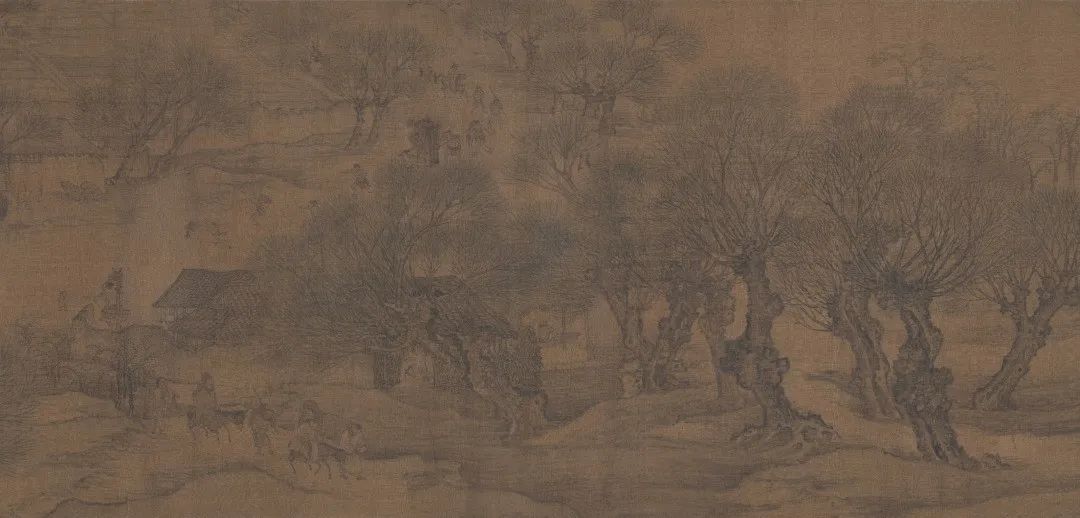
Along the River During the Qingming Festival(detail No.3)

图5 [南宋]扬无咎,《四梅图》(局部之一),纸本,墨笔,纵37.2厘米,横358.8厘米,故宫博物院
Yan Wujiu, Four Stages of the Blossoming Plum Trees(detail No.1),ink on paper 37.2×358.8cm , the Southern Song Dynasty , the Palace Museum
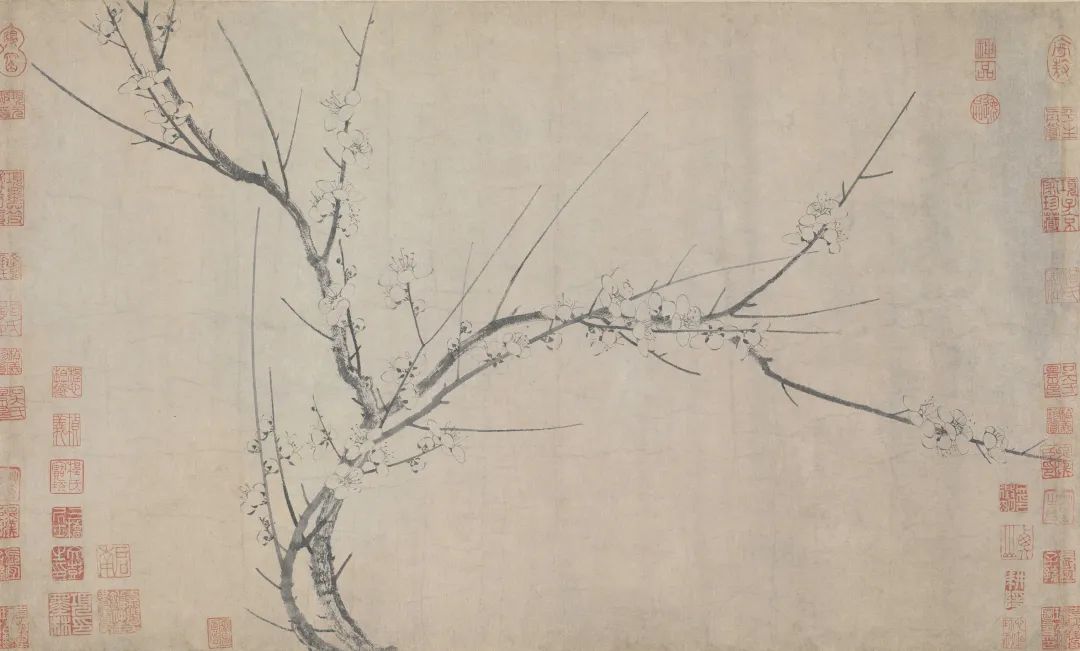

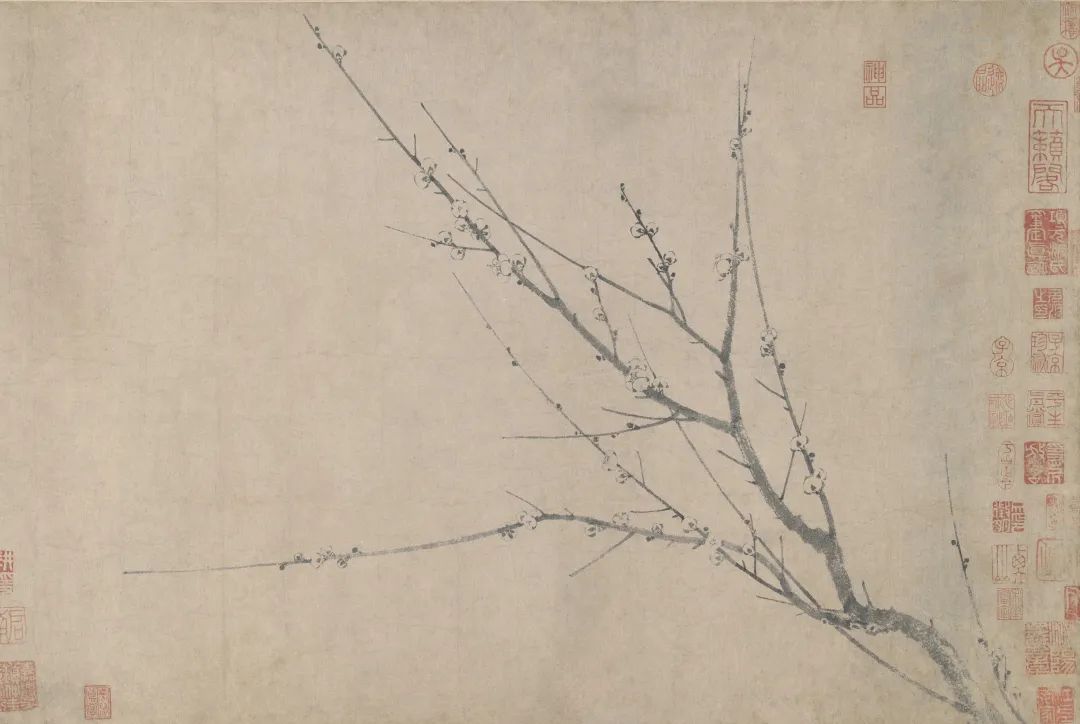
《富春山居图》(局部之二)Dwelling in the Fuchun Mountains(detail No.2)

Dwelling in the Fuchun Mountains(detail No.3)

Dwelling in the Fuchun Mountains(detail No.4)

Wang Mian,Plum Blossoms,ink on paper, ink on paper,68×26cm ,Yuan Dynasty,Shanghai Museum
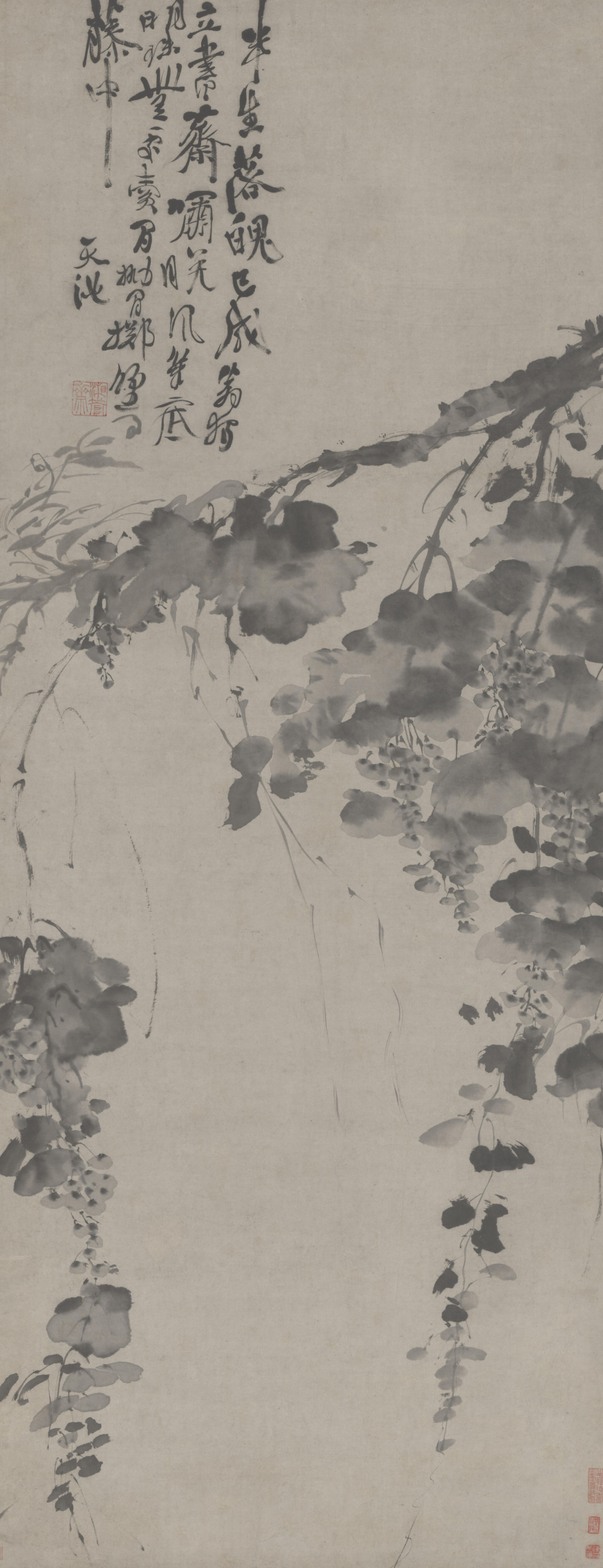
中国文人画家对于境界的追求,绝非是一种对景观和物象的真实描摹,而是一种感物道情的格物致知和澄怀味象的人生感悟。他们通过水与墨的交融与幻化,用手中的笔,书写大写的人生希冀,描绘世间的美善之境。他们用心中的诗句,抒发胸中的志向,纾解怀中的块垒。他们用中国绘画独特的写意方式,在精神世界和现实世界中进行着意象切换,最终呈现出一种对高贵人格的笃守和高雅性情的操守。这不能不说是源自对东方写意精神的深邃解读,对天下苍生,对世间百态,对天地道德的真心感悟和智慧升华。
The pursuit of the Chinese literati painters was never a realistic depiction of landscapes and objects, but rather a sense of life that clarifies the mind reflected in the image. Through the interplay and illusion of water and ink, they used the brush in their hands to write down the hopes of life, the ultimate beauty and goodness in the world.They use the poetry of their hearts to express their aspirations and relieve the struggles in their mind. They use Chinese painting's unique way of writing to switch in-between the spiritual and the real world, presenting the sense of commitment to the noble and elegant personality. This is the profound interpretation of the spirit of oriental Xie Yi painting, a sincere perception and sublimation of the wisdom of the world.
对写意问题的思考和诠释,其实一直都未曾间断。宋代韩拙说:“用笔有简易而意全者,有巧密而精细者,前者乃指写意。”元代夏文彦在《图画宝鉴》卷三中讲:“仲仁以墨晕作梅,如花影然,别成一家,所谓写意者也。”清代恽寿平说:“宋人谓能到古人不用心处,又曰写意画。两语最微,而又最能误人,不知如何用心,方到古人不用心处;不知如何用意,乃为写意。”近现代中国画四大家吴昌硕、齐白石、黄宾虹、潘天寿,他们用他们的画作,向我们呈现了具有东方神韵和中国气派的写意绘画作品,值得后人敬仰和深入探讨。
The thinking and interpretation on Xie Yi has, in fact, never ceased. Han Zhuo,from the Song dynasty, said, "There are those who use the brush with simplicity but full of content, and those who use the brush with delicacy and density, the former refers to Xie Yi ."Xia Wenyan from the Yuan dynasty said in Volume 3 of his Precious Mirror of Painting,: "Zhongren paint plum with ink halo, like the shadow of a flower. His unique approach can be seen as Xie Yi .” Yun Shouping from the Qing dynasty says: "The Song people said that they were able to reach the place where the ancients did not put their hearts. They also said this is Xie Yi. The two sayings are the most subtle and misleading, for if one does not know how to heart, one can reach the place where the ancients did unconsciously; if one forget to use the mind, one can Xie Yi ." The four great masters of modern Chinese painting, Wu Changshuo, Qi Baishi, Huang Binhong and Pan Tianshou all have in their paintings to presented us with oriental charm and Chinese style, which deserve to be admired and discussed in depth by future generations.
华夏民族是一个崇尚写意精神的民族,这种写意精神,不仅仅存留在中国绘画中,而是一种融入血脉中的气质。这种气质使我们具有宽容、乐观、坚韧、勤勉的秉性,也具有淡然、从容、洒脱、豪迈的性情。这些宝贵的禀赋,被一代代传承,形成一种至尊无上的大写意精神。或许,这也是中国文化自古迄今延绵不断的真正原因。
Chinese people admires the spirit of Xie Yi, a spirit that is not only present in painting, but also is embedded in the bloodline.This quality gives us the tolerant, optimistic, resilient and diligent nature, as well as breezy, relaxed, spontaneous and bold character. These valuable endowments have been passed down from generation to generation, forming a supreme spirit of Xie Yi. Perhaps this is the real reason for the continuity of Chinese culture from ancient times to the present day.
总之,写意对中国人而言,既是一种艺术样式,也是一种生活方式和思维方式。同时,写意也是一种基于大千世界林林总总物象存在的意象化诠释与升华,是用一种“易”的不确定性对事物变化发展的训诂,这种思维诠释具有鲜明的个性化和倾向性特征。几千年来,华夏先民在生产和生活中逐渐形成了具有东方格调和审美意蕴的写意文化,这种写意文化渐而转变为一种文化基因,直接或间接地影响着中国绘画的生成和走向。最终,写意绘画成为华夏民族在艺术领域中一道独特的风景线,并被一代一代传承和推广开去。
In short, Xie Yi is not only an art style, but also a way of life and thinking. It is also an interpretation and sublimation of imagery based on the existence of a wide range of objects in the world, an exegesis of the changing development of things with the “uncertainty”. It is a way of thinking that is distinctly individual and tendentious.In thousands of years, Chinese ancestors have gradually developed an oriental aesthetic culture from their life, which has gradually transformed into a cultural gene, directly or indirectly influencing the creation and direction of Chinese painting. Ultimately, this painting style has become a unique landscape in Chinese art, and has been passed on and promoted from generation to generation.
以上皆为个人见地,聊以卮言,一蹴而就,为期嘤其鸣矣,求其友声,仅此搁笔,与君共勉旃!
All of the above are personal opinions, finished in one go. For the time, I want to use this voice to seek acquaintances’ voice. I’ll stop here and looking forward to your interactions!
戊戌仲春谷旦于西子湖畔
By West Lake, Spring of 2019
[1] The literal translation of the term is to write down the meaning. As Chinese painting uses the same brush and techniques for writing, painting is often referred as writing. In the context of Chinese painting, it refers to the freehand and impressionistic painting style.
文字、图片:韩璐翻译:朱朱编辑:张松林、陈量、范阳子审核:花俊Articles and pictures: Wang Dongling StudioTranslation: Zhu zhuEditor:Zhang Songlin,Chen Liang , Fan YangziAudit: Hua JunEND.
